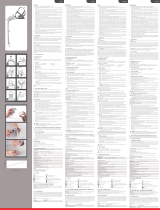
2
GENERAL WARNINGS
• The vent holes must be kept clear.
• The mask should only be used with CPAP or bilevel devices
recommended by a physician or respiratory therapist.
• The mask should not be used unless the device is turned on. Once
the mask is fitted, ensure the device is blowing air. Explanation:
CPAP and bilevel devices are intended to be used with special
masks (or connectors) which have vent holes to allow continuous
flow of air out of the mask. When the device is turned on and
functioning properly, new air from the device flushes the exhaled
air out through the mask vent holes. However, when the device is
not operating, insufficient fresh air will be provided through the
mask, and the exhaled air may be rebreathed. Rebreathing of
exhaled air for longer than several minutes can, in some
circumstances, lead to suffocation. This applies to most models of
CPAP or bilevel devices.
• Follow all precautions when using supplemental oxygen.
• Oxygen flow must be turned off when the CPAP or bilevel device
is not operating, so that unused oxygen does not accumulate
within the device enclosure and create a risk of fire.
• Oxygen supports combustion. Oxygen must not be used while
smoking or in the presence of an open flame. Only use oxygen in
well ventilated rooms.
• At a fixed rate of supplemental oxygen flow, the inhaled oxygen
concentration varies, depending on the pressure settings, patient
breathing pattern, mask, point of application and leak rate. This
warning applies to most types of CPAP or bilevel devices.
• The technical specifications of the mask are provided for your
clinician to check that they are compatible with the CPAP or
bilevel device. If used outside specification or if used with
incompatible devices, the seal and comfort of the mask may not
be effective, optimum therapy may not be achieved, and leak, or
variation in the rate of leak, may affect the CPAP or bilevel device
function.
• Discontinue using this mask if you have ANY adverse reaction to
the use of the mask, and consult your physician or sleep therapist.
• Using a mask may cause tooth, gum or jaw soreness or aggravate
an existing dental condition. If symptoms occur, consult your
physician or dentist.





















